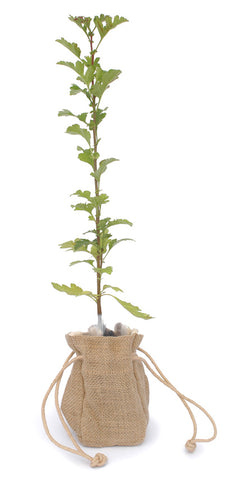Hawthorn Tree Facts and Information
Hawthorn Tree Facts and Information
- Latin: Crataegus monogyna
- Native Words: Old Irish (droigheann), Old English (hage), Welsh (draenen wen / ysbydadden)
- Ogham Sign:
- Height When Mature: 10–14m (33–46ft)
- Height After 10 Years: 3m (10ft)

Hawthorn Botanical Description
The common hawthorn (Crataegus monogyna) is one of two native hawthorn species, the other being C. oxycantha. The key difference is that monogyna has one seed per fruit, while oxycantha has two. Native to the UK and found worldwide, hawthorn produces fragrant white flowers in spring known as ‘May Blossom’, which attract early insects.
Hawthorn flowers appear later than blackthorn, typically in April or May. Unlike blackthorn, hawthorn leaves appear before the flowers. Leaves are deeply lobed, and shoots develop into spines. The red fruit (haws) ripen in October and may linger through winter. Its bark is often shiny, and in upland areas, crowns are shaped by prevailing winds. Mature trees can exceed 30ft in height.
Natural History and Ancient Wisdom
A true pioneer species, hawthorn colonizes scrubland and is often replaced over time by ash or oak. It is closely tied to hedgerows and enclosures, with the Anglo-Saxon word "haga" meaning both hedge and hawthorn. Used extensively during the 18th–19th century for livestock enclosures, it's also known as “quickthorn” for its fast growth.
Hawthorn has deep folklore roots. It was central to May Day rituals, and lone “fairy thorns” still stand in fields. Superstitions suggest bad luck if hawthorn blossom is brought indoors.
The practice of hedge laying often involves hawthorn. Trees are cut almost through and laid flat to regenerate denser growth in spring. Medicinally, hawthorn leaves, berries, and flowers are used to improve circulation and treat high blood pressure, anxiety, and indigestion.

Hawthorn Place Names in the UK
- Woodmansterne (Surrey) – "thorn on the edge of a wood"
- Appleton Thorn (Cheshire)
- Hatherdene (Hampshire) – "hawthorn valley"
- Hathern (Leicestershire) – "hawthorn"
Hawthorn Wildlife Rating
Hawthorn supports a wide range of wildlife. It is a host for the Duke of Burgundy butterfly, yellow-tail moths, hawthorn shield-bugs, and is a food source for Magpie and Lackey moths. Small Eggar larvae form webs on its leaves, while the flowers attract flies for pollination.
The haws provide food for wood mice and birds, especially thrushes. The dense thorny growth makes excellent nesting cover for small birds.
Hawthorn Good Points
- Highly tolerant of exposed positions and makes an excellent impenetrable hedge.
- Thrives in well-drained soils and even large containers.
- Can be grown as a standard tree and clipped to shape.
- Profuse spring blossoms make it very attractive in gardens.
Hawthorn Bad Points
- Sharp thorns remain on dropped twigs and can puncture tyres or injure skin.
Buy a Hawthorn Tree
Tree2mydoor offers native tree saplings as gifts for loved ones. Our Hawthorn Tree Gift is ideal for weddings and springtime occasions. If unavailable, consider our Rowan Tree Gift – a similarly hardy native with beautiful red berries and fewer thorns.